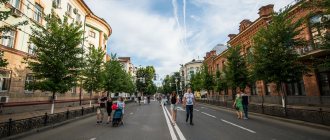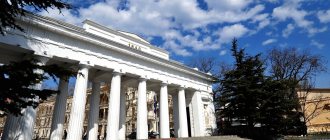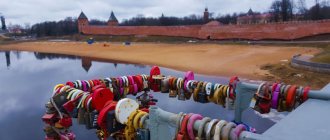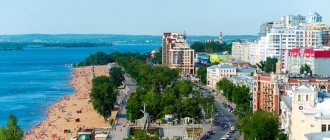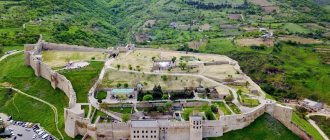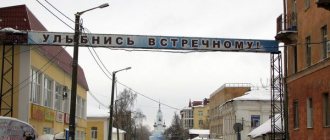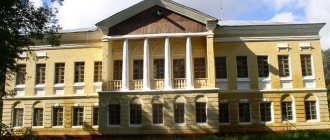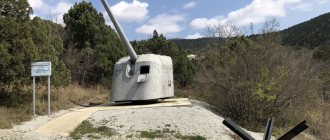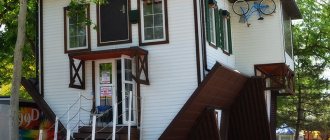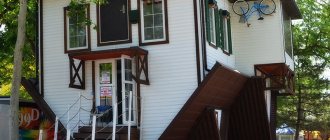Home » Russia » Abkhazia
Buy cotton masks on Aliexpress at a discount!
- 1 Territory, capital and population of Abkhazia
- 2 Brief history
- 3 Territory and population of the country
- 4 Religion on the territory of Abkhazia
- 5 The capital of Abkhazia Sukhum
- 6 Natural advantages of the city
- 7 Climate
- 8 Cultural heritage
- 9 Is it worth vacationing in Sukhum?
Abkhazia is a small country, but it has an incredible history, many beautiful places to visit, and a wonderful, hospitable population.
Territory, capital and population of Abkhazia
The republic is located in an incredibly beautiful place - in the North-West of the Caucasus. Washed by the Black Sea, almost the entire territory of Abkhazia is occupied by the most picturesque mountains - the spurs of the Caucasus massif, the Gagra ridge, the Bzyb ridge and many others.
From this information it follows that the country has the cleanest air and beautiful views, which contribute to the development of tourism in the country. People come to Abkhazia for various purposes - health improvement, entertainment, spiritual enrichment, personal education.
The capital of Abkhazia, the city of Sukhum, deserves special attention.
View of the capital of Abkhazia
When arriving in a new country, it is important to know about its population, characteristics and traditions - you can glean this information from this article.
Transport
You can get to Sukhumi by bus, train and plane. Unfortunately, all of these methods are illegal. The only correct way to legally enter Abkhazia is to cross the bridge over the Inguri, arriving in the Georgian town of Zugdidi. You must cross the bridge on foot or in a paid carriage. To “legally” enter Abkhazia you need to obtain a “visa” from the de facto authorities of Abkhazia. You can request and receive a visa online. On the other side of the bridge, in territory not controlled by Georgia, you can take a minibus or hire a taxi and get to any place in Abkhazia.
As for public urban transport, trolleybuses and minibuses operate in Sukhumi. There are only three trolleybus routes in Sukhumi.
Remember that according to Georgian legislation, Abkhazia and South Ossetia are considered occupied territories.
Accordingly, by visiting these territories from the Russian side, you are breaking the law. This leads to a fine of 400-800 GEL and other troubles.
If you have a stamp in your passport about visiting these territories, it is better not to go to Georgia with this document.
If you want to visit Abkhazia or Ossetia legally, do it from the Georgian side. Get official permission and there will be no problems. Read more about this on the website of the Georgian Ministry of Foreign Affairs: www.mfa.gov.ge
Short story
From the location of the republic it becomes clear that the population of Abkhazia descends from the ancient people of the Western Caucasus. Various ancient sources mention such peoples as Abeshla and Abazg. The Greek colonies had a positive influence on the development of the Abkhaz people. It was Greece that contributed to the development of the economy. The active development of trade began during the reign of the Roman Empire.
Later, three principalities were formed on the territory of present-day Abkhazia - Apsilia, Abazgia and Sanigia. They united after an unsuccessful battle with Arab troops, and then the Abkhazian kingdom was formed.
Country map
Much later, at the beginning of the 19th century, Abkhazia joined Russia, and during the Soviet Union the Abkhaz SSR appeared.
At the moment, the independence of the republic is recognized by some UN member countries.
Territory and population of the country
A not very large country, with an area of slightly less than 9 thousand square kilometers, is located in Transcaucasia and borders on Russia and Georgia. Abkhazia is framed on both sides by the Psou and Ingur rivers. The republic is protected from the north by mountain ranges; on the south side there is a sea coast. Entry into the country is currently possible only from the Russian Federation. It should be noted that citizens of the Russian Federation need only have an internal passport to enter Abkhazia; there is no need for a foreign one.
The country's population is small - according to the 2021 census, the country is home to approximately 243 thousand people. Most of the population lives not in large cities, but in rural areas.
data-matched-content-ui-type=”image_card_stacked”
Abkhazia is considered a multinational state - in addition to the indigenous Abkhazians, Russians, Armenians, Greeks and Georgians live there in large numbers. In addition, in the country you can meet Ukrainians, Estonians, Jews and many other representatives of different countries.
Green capital Sukhumi
People in Abkhazia speak the Abkhaz language, the second official language is Russian. You can also pay in two currencies in the republic - the Russian ruble and local apsaras.
Quite interesting is the main symbol of the country - the state flag. It is a rectangle with alternating white and green vertical stripes. In the upper right part there is a small purple rectangle with the image of a palm and seven stars. The flag symbolizes 7 historical regions of Abkhazia.
Religion on the territory of Abkhazia
Despite the multinational population of the country, the majority of residents of Abkhazia consider themselves Christians. However, there are also adherents of other religions - Muslims, pagans, adherents of the Abkhaz religion, atheists, etc.
It is important to know that the majority of the indigenous population prefer long-standing Abkhaz monotheism to the world religion, although they consider themselves Orthodox Christians. Adherents of traditional religion believe in one, invisible God - the Creator of all things. He is the focus of all known concepts, he himself is Nature.
Amazing architecture
The capital of Abkhazia is Sukhum
The city of Sukhum is located on the sea coast of the Republic of Abkhazia, occupies approximately 23 square kilometers and is the largest populated area in the country. The current capital of Abkhazia, Sukhum, also arose thanks to the influence of Greece - the city was built by merchants on the territory of ancient settlements. The capital had many names; the city finally acquired the name Sukhum after the collapse of the Soviet Union.
The capital has many historical and architectural monuments of different times and styles, important religious buildings and simply beautiful sights - the botanical garden, the Sukhumi lighthouse, Bagrat Castle and many other important buildings.
The city has excellent transport links - city buses, railway connections, and Babushara Airport is located not far from Sukhum.
There are several secondary specialized educational institutions in Sukhum, as well as the Abkhaz State University.
At the moment, tourism is actively developing in Abkhazia in general, and in Sukhum in particular. The capital has many hotels, sanatoriums, convenient for recreation, sightseeing tours and various other places for entertainment and recreation.
Streets of Sukhumi
The legendary Sukhumi market is truly considered an important element of the capital - residents from all over Abkhazia come there to shop. Tourists also love to visit the market, because the cost of products there is low, and the selection and quality of goods exceeds all expectations.
What to bring
There is practically no industry in Abkhazia; all the best on its shelves are gifts from Mother Nature: nuts, fruits, all kinds of preserves and cheeses, tkemali sauce, spicy adjika and sweet churchkhela. Abkhazian honey is at the top of this list. Its secret is in mountain herbs and the Caucasian gray bee with a very long proboscis, allowing it to get nectar from the very depths of the flower.
Suluguni cheese - from 250 RUB/kg, eucalyptus honey - from 800 RUB/kg, walnut jam - 350 RUB per 0.5 l jar, smoked trout - 650 RUB/kg.
It is better to buy local wine in the store, giving preference to white wines from the Sukhumi winery: semi-sweet “Psou”, semi-dry “Anakopia” and dry “Dioskuria”. Most red wines - “Lykhny”, “Radeda”, “Eshera”, “Bouquet of Abkhazia” - are made from Isabella grapes, which are banned in the European Union and the USA. The exceptions are semi-dry “Apsny” and dry “Chegem”. For those who like it hot, there is homemade chacha in almost every Abkhazian yard. Several years ago, its industrial production was established here under the Achara and Chegem brands, the price is 380-1000 RUB per bottle.
Natural advantages of the city
As mentioned above, Sukhumi is located on the sea coast, which immediately indicates the presence of many beaches and wonderful air in the city. The snow-capped mountain peaks visible in the distance are also pleasing to the eye.
The beaches mostly have pebble or sandy-pebble shores, many of them are well equipped and have all the amenities for a comfortable stay for local residents and tourists. Some beaches belong to hotels and sanatoriums, therefore, before visiting, you need to find out the conditions for entry to them. Prices for sun loungers and other beach equipment are quite affordable.
There are several wild beaches in Sukhum, which, although devoid of comfort, will give you the opportunity to feel the nature of the city directly, alone and without advertising signs disturbing your eyes.
Thanks to the maritime climate, the city is filled with many exotic plants; palm trees and eucalyptus trees are planted on the well-known embankment, which help improve the respiratory system of city residents and guests of the capital.
Nature of the city
Treatment
The sanatorium and medical base in Sukhum, inherited from the USSR, has practically been lost. Former sanatoriums and boarding houses have become ordinary hotels and recreation centers with dilapidated walls and poorly maintained tropical parks. The only surviving sanatorium with treatment is “Apsny”. Here they help get rid of arthritis, osteochondrosis, hypertension, diseases of the respiratory system and nervous system. The cost of consultations with specialists and medical procedures is incredibly low - from 100 to 800 RUB, accommodation in a double room with full board - 1500-1700 RUB per person per day.
Despite the almost complete disappearance of sanatoriums, the natural factors that made Sukhum a popular Black Sea resort - healing mineral springs, sea air filled with phytoncides, etc. - are still in demand. The positions of the disappeared sanatoriums are now taken by hotels with spa and fitness centers, such as Atrium-Victoria and Caracas. True, the list of health and relaxation procedures they offer is small, mainly massage, cosmetologist services using local mountain herbs, relaxing salt saunas and Turkish baths, herbal barrels, exercise in the gym, and swimming pools with hydromassage.
Climate
Another advantage of the city of Sukhum is its climate. There is practically no wind in the city, however, light sea breezes completely compensate for the summer heat and reduce air humidity. In cold weather, the mountain masses bring warmth to the city and raise the air temperature to a comfortable level for relaxation.
Thanks to such a mild and warm climate, Sukhum has a fairly long swimming season - from the beginning of May to the end of October, the sea temperature remains pleasant. The average water temperature by the end of summer is about 25°. The sea in Sukhum is always clean and pleasant.
Another merit of the city’s climate is the ability to grow a wide variety of plants on the territory of Sukhum. Beautiful thujas, palm trees, and cedars grow not only in the botanical garden, but simply on the streets of the city. Even in winter, the city remains incredibly beautiful - after all, some flowers love the Abkhaz climate so much that they bloom there even in winter.
Sights of Sukhumi with photos
The most famous and ancient architectural monument in Sukhumi is the Sukhumi Fortress, you can see the photo below. It was built by the Romans and called “Sebastopolis”, which means “Holy City”. Today, only ruins remain of the fortress, which symbolize the history of the city.
Among the significant architectural monuments one can also highlight the Great Abkhaz Wall . It was erected during the Byzantine period of history. The wall stretched 160 km in length and consisted of small towers 8-12 m high. Now ruins remain of the wall, but some towers are well preserved.
Moving on to an overview of the sights of modern Sukhumi, first of all I would like to highlight the Botanical Garden . It occupies a leading place among arboretums around the world. It contains plants from subtropical regions around the world. The garden contains more than 5,000 varieties and varieties of plants. The main exhibit is the Caucasian linden tree, which is more than 250 years old.
An amazing place that was once world famous is the Research Institute of Experimental Pathology and Therapy of the Academy of Sciences of Abkhazia, known as the Monkey Nursery , which is located on Mount Trapezium. There are more than 300 individuals of various monkey species from Africa, Asia and South America.
Are you going to Georgia? Write to [email protected] - we will create the optimal travel route for you. Come and we will try to make your vacation unforgettable! You can get a free consultation by phone: +7 or +995 555 566 540
On the territory of the institute you can visit the primatological museum; there is also a monument to a monkey erected here.
The attractions of the resort Sukhumi are the Makhadzhirov embankment and the Dioskouri embankment . One embankment smoothly transitions into another, in fact it is one embankment, they are even paved with the same masonry.
The embankments are the main recreational area for city residents and vacationers. From here you have an excellent view of the sea, and on the other side of the embankment there are old colorful buildings. The atmosphere is complemented by exotic plants that grow on the embankment.
In Sukhumi, as throughout Georgia, gambling is allowed, so the city has several casinos designed for both visiting tourists and the local population.
Cultural heritage
In addition to the above advantages, Sukhum is the cultural center of Abkhazia.
The main cultural building of the city is deservedly called the Sukhumi Fortress. It was built in the 17th century and for a long time the city of Sukhum was located in it. Despite the fact that the fortress is very poorly preserved, it is the most important nature reserve in the capital.
The capital is rich in interesting monuments that are dedicated to historical figures and events, and fit perfectly into the beautiful landscape of the seaside city.
In addition to the fortress, there are several museums in Sukhum, including an ancient local history museum, where you can get acquainted with the history of the country, and an art gallery, which contains more than three thousand beautiful works.
Also in the capital, the State Philharmonic Society was recently reconstructed, and the drama theater is the most significant in Abkhazia and has a fairly extensive repertoire.
It should be noted that not only tourists consider Sukhum a beautiful city - the capital often becomes a desired subject for filming, and some areas of Sukhum can be seen on the screen.
How to get there
You can get to the city of Sukhum, located in Abkhazia, by yourself by private car, or by using the services of passenger transport companies that offer the consumer three options: plane, rail and bus.
Air:
You can get to Sukhum by plane from anywhere in the world, choosing Adler-Sochi Airport as your final destination, from which buses regularly depart to the border with Abkhazia. In addition, you can order a taxi at the airport, which will significantly save time.
When crossing the Russian border with Abkhazia at Psou, located 20 minutes from the airport, you will need to undergo baggage inspection and other customs procedures, but the entire process takes approximately 5-10 minutes, in addition, there is no need to pay customs duty.
The parking lot for regular buses heading to Sukhum is located immediately behind the checkpoint on the Abkhaz side. The travel time from the border to the destination is approximately 1.5 hours, and the distance is 100 km.
Railway:
By rail, without transfers, you can get to Sukhum only from Moscow or other cities located along the route of the Moscow-Sukhum train. There are no direct trains on other routes, but you can look for direct flights to Adler.
If upon arrival or arrival in Adler there is no desire to stand in line at a pedestrian or automobile checkpoint, you have the opportunity to use a comfortable commuter electric train.
This train, departing from Adler station every day at 07:30 in the morning, can reach Gudauta, New Athos, Gagra and Sukhum itself. You can also return to Adler on this electric train. It departs from Sukhum daily at 17:45.
Bus:
Today, there are quite a few regular buses that can be used to get to the city without transfers.
The main bus routes with an end point in Sukhum depart from the cities:
- Moscow;
- Krasnodar;
- Nalchik;
- Krymsk;
- Rostov-on-Don;
- Cherkessk;
- Sochi;
- Vladikavkaz;
- Volgograd.
Prices for travel on these buses depend on the distance between the starting and ending points, as well as on comfort. The schedule and ticket prices should be checked in advance at the bus station in the city of departure.
Is it worth vacationing in Sukhum?
Undoubtedly, Sukhum is a wonderful place for relaxation and recovery, however, here are a few main reasons why the capital of Abkhazia is a must-visit:
- During the Soviet Union, Sukhum was the main holiday destination that everyone dreamed of. Over the years, the capital has only developed, so you definitely need to visit the place that our parents dreamed about, and which is now available to us.
- The stunning climate of the capital certainly attracts tourists to its territory, and the beautiful beaches only complete the picture of an ideal vacation.
- Although Abkhazia is developing tourism, you won’t see crowds of tourists in the capital yet; the roads are pleasing to the eye with their emptiness, and the beaches with their cleanliness and holiday tranquility.
- The variety of local wines, fresh fruits, and exotic local dishes deserve special attention and are very popular among those people who value authenticity and the preservation of old recipes.
- The variety of natural areas in Abkhazia is amazing. In one day you can sunbathe on a beautiful public or wild beach and visit mountain ranges with glaciers and caves.
- Local residents are always friendly and can delight you with homemade treats, interesting stories and local folk culture.
- With the development of tourism in the capital, new entertainment centers and restaurants are opening - there will always be somewhere to eat and spend time. Moreover, Abkhazians glorify not only their cuisine - in Sukhum there are many restaurants with European cuisine and excellent quality of service.
- Not far from the capital there is the Gagra water park, which can diversify your vacation and delight the whole family with unforgettable emotions.
Sukhum is the most picturesque capital of Abkhazia, you will never regret a holiday in these places and will definitely want to throw a coin into the famous fountain with griffins in the square near the theater on the last day of your vacation, because it is impossible to fully explore the city in one trip, it is so diverse and attractive.
Rent a Car
Renting a car is a good opportunity to expand the geography of your holiday and get acquainted with the natural beauties of Abkhazia. Car rental in the republic is supported by locals and Bekar-Auto, whose offices are located near the border crossing in Psou. The cost of renting an economy class car (Nissan Micra) upon pre-order is 2000 RUB/day or 9800 RUB/week. Plus local insurance of 1900 RUB and a security deposit of 5000 RUB (refundable at the end of the rental). Traveling outside of Abkhazia in a rented car is not allowed.
The fine for speeding by 10-30 km/h is 600-1800 RUB, driving into oncoming traffic is 5000 RUB, driving while intoxicated is up to 12,000 RUB. The best gasoline in Sukhum is at Rosneft gas stations.
Most parking in the city is free. Official paid parking is only available near the Central Market (50 RUB/day). Everything else is a private initiative of local entrepreneurs, who earn 50-100 RUB from each car. There are practically no traffic jams, but the driving style of Abkhaz drivers may seem too aggressive. On country roads, one is struck by the abundance of speed limit signs, which are vigilantly watched by the owners of striped sticks sitting in ambush.
If you only need a car for 1-3 days, you should consider renting a car with a driver. It costs 3000-4000 RUB/day.
